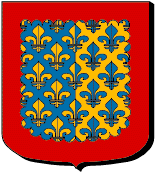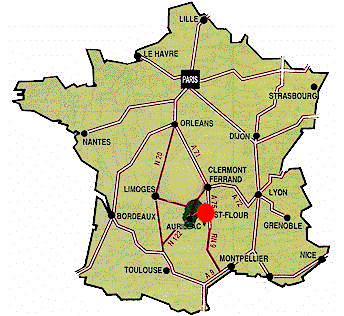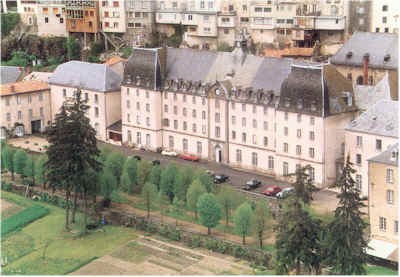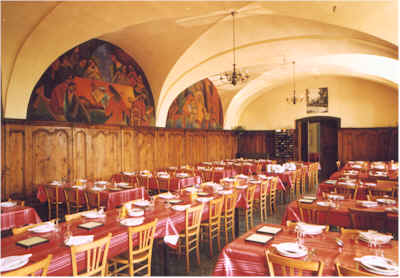

|
|
The subject of the school will be biological aspects and mathematical
methods of population dynamics in connection with cell and molecular
biology.
The following are the main classes. The number in parentheses is
approximately the number of lectures for each class:
1. Biological mechanisms of cell proliferation (Bela Novak and
John Tyson) (6)
2. Cell-Cycle and Cancer (Zvia Agur) (3)
3. Modeling of cell population dynamics (Glenn Webb) (6)
4. Branching processes in cell and molecular biology (Marek Kimmel
and Ziad Taib) (9)
5. Mathematical analysis of cell population models (Ovide Arino
and Eva Sanchez) (6)
6. Estimation of parameters of cell kinetics (Alessandro Bertuzzi
and Alberto Gandolfi) (6)
7. Tumor growth and spatial growth (Mark Chaplain and Philippe
Tracqui) (6)
Additional lectures, workshops and informal discussions will be
organized in the afternoon and in the evening. The language of the
school is English. Documentation will be considered essential.
Each lecturer will be required to prepare lecture notes to be
handed to the school participants.
Duration of the school is two weeks, including 10 days of
classes, Monday through Friday.
The number of participants is limited to 50.
PhD students and postdoctoral fellows are encouraged to apply.
The organizers may obtain funding for partial financial support
for a limited number of school participants.
 |
Saint-Flour, a lively small town in the pictoresque Massif Central region, is the old capital of the Haute Auvergne. |
| The school will take place in the Grand Seminary of St.-Flour which recently has been converted into a well equipped conference center accomodating up to 100 people. The French Society for Theoretical Biology has held its three recent annual meetings at the Grand Seminary. | 
|
 |
|
1. Biological backgrounds I.:
Physiology of the cell cycle: the cell cycle, coordination of growth and
division, size control, the role of nucleo-cytoplasmic ratio, early size
control models, checkpoints: START, entry into- and exit from mitosis.
2. Biological backgrounds, II:
Genetics and molecular biology of the cell cycle, cell cycle mutants, cyclins
and cyclin-dependent kinases, the cell cycle engine.
3. Modelling mitotic control:
Kinetic models describing M-phase Promoting Factor regulation in early
embryos and growing cells, simple (2D) and detailed (multi D) models
explaining experiments by cell free extracts and by fission mutants.
4. Modelling START in budding yeast:
The transcriptional activation at START, transcription factors and G1
cyclins, the relation of G1 and G2 cyclins.
5. Modelling START transition in fission yeast:
The role of cyclin dependent kinase inhibitor (rum1) in ordering S- and
M-phases in the cycle, kinetic models describing endo-reduplication and
mitotic cycles.
6. Modeling the meta-phase / anaphase transition:
Kinetic models of cyclin ubiquitination, hysteresis in the ubiquitination
system.
1. A minimalistic model for the cell-cycle and its implications.
2. The role of time-delays and slow processes in determining the stability
of the cell-cycle.
3. Can analysis of the nonlinear properties of the model serve for
understanding major transition points in development? Can our conclusions
be applied to the control of cancer?
4. Insights from models and experiments in cancer/AIDS chemotherapy:
the
role of G0.
5. How to define the global properties of cell-cycle control?
1. Cell population models as dynamical systems:
Cell population processes can be modelled as differential equations,
difference equations or functional equations in population state spaces.
The population behavior can be described by analysis or computer
simulation of the solutions of the equations. An example of such a
population process is the loss of telomeres on the ends of chromosomes
as cells divide. Telomere loss is believed to have an important role in
cell senescence and the distinction of tumor and normal cells.
2. Cell population models with quiescent subpopulations:
Quiescent cells are an important consideration in many cell population
processes, especially tumors. The transit of proliferating cells to
quiescence or the recruitment of quiescent cells to cycling can be modelled
as dynamic processes which effect the stabilization of the cell population.
3. Cell population models of tumor growth:
A tumor can be viewed as a population of cells. The growth of the tumor
is a dynamic process in which proliferating and quiescent classes of cells
interact. The typical Gompertzian growth of tumors can be modelled by
nonlinear differential equations describing the interactions of
proliferating and quiescent tumor cells.
4.Models of tumor chemotherapy:
Tumor chemotherapy is a population loss process that can be described
qualitatively by population models. Chemotherapy typically effects only
proliferating cells and thus the recruitment of quiescent cells to cycling
during therapy is of essential importance in treatment.
5. Cell population models of the HIV infected immune system:
The HIV infected immune system can be viewed as a system of differential
equations for the populations of uninfected CD4 T-cells, the infected
CD4 T-cells, and the virus. The progress of AIDS can be described by the
interactions of these populations.
6.Models of AIDS chemotherapy:
AZT or other chemotherapy treatment of AIDS can be described qualitatively
by models of the HIV infected human immune system. The inclusion of drug
resistant viral strains in these models is of essential consideration in
designing treatment strategies.
7.The blood production system:
The blood production system can be viewed as a population process
which is controlled by nonlinear feedback mechanisms. The normal blood
production system is stable under perturbations, but the abnormal system
(such as aplastic anemia) is not. Aplastic anemia can be modelled as a
population process that is unstable as a result of a defective starting
condition.
1. Mathematical modelling, an introduction
2. Biological background
3. The Galton-Watson process
4. The age-dependent process
5. The general age-dependent branching process
6. Countable type processes
7. Branching processes with abstract type spaces
1. A survey of mathematical models of cell population dynamics:
Through the survey, some of the main issues of cell population dynamics will
be reviewed. The strong development of linear structured models during the
1980-90 decade will be more particularly focused on.
2. Linear age and size structured models:
Asynchronicity is the main topic of this lecture. Its significance and
conditions implying it will be thoroughly reviewed.
3. Nonlinear models:
Density-dependence produces limitations in cell proliferation. This may lead
to either a homeostatic distribution with an equal balance of incoming and
outgoing cells, or non constant equilibria, ranging from periodic to
aperiodic or chaotic behavior. The lecture will present two directions that
have been followed recently in the study of such models: i) the development
of a theory of nonlinear cell population models; ii) uncoupling of nonlinear
(population) effects and linear (individual growth) effects.
4. Comparison of models:
The lecture will present some of the attempts made by several researchers
during the last fifteen years for introducing some order amongst the various
models which have been proposed:from phenomenological to mechanistic, from
deterministic to stochastic, from the level of the populations to the level
of the cells down to the level of genes and biochemical substances.
This latter aspect will be expounded in the next lecture.
5. Models incorporating mechanisms of molecular biology:
This lecture focuses on models derived from the study of biochemical factors
of the cell cycle. It covers the two views under which this study has been
made: first, researchers concentrated on the evolution of the species,
independent on the cell population. Models derived according to this view
are essentially either simulation models or ordinary differential equations,
possibly with a large number of variables. The other view combines
the biochemical and the population approaches. It is presented in its
biological context in the course on "Biological mechanisms of cell
proliferation" where a model will be built.
The lecture will mainly address some of the mathematical issues of the model,
both its qualitative features and its comparisons with other models.
1. Reaction-diffusion models and tumour growth:
(a) dynamical analysis of brain tumour growth (P. Tracqui)
2. Reaction-diffusion models and tumour growth:
(b) patterns formation at the tumour surface (M. Chaplain)
3. Modelling angiogenesis during tumour development (M. Chaplain)
4. Modelling mechano-cellular interactions at the tumour border (P. Tracqui
and M. Chaplain)
5. Modelling the immune response to cancer (M.Chaplain)